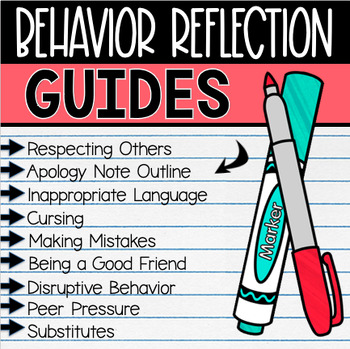Behavior Reflection Guides | Discipline Forms
What educators are saying
Description
There is much more to discipline than punishment or dealing out consequences. Students must learn something from their mistakes in order to improve. These behavior reflection guides include both opportunities for students to learn WHY their behavior is unacceptable and HOW they should act in the future. These behavior forms are filled with facts and practical activities for students to reflect on their behavior, learn from it, and make things right.
In this resource, you’ll find a variety of reflection guides to address typical misbehaviors in upper elementary and middle school.
What's Included?
Activity #1: Respecting Others
This activity is perfect for any student who did something disrespectful to another student, such as spreading rumors, saying something unkind, or calling names. For this activity, students learn about The Golden Rule, reflect on quotes about respect, admit their mistake, and decide how to make it right. Follow this up with the Apology Note Outline (Activity #2) if appropriate.
Activity #2: Apology Note Outline
Simply saying “I’m sorry” is not enough. This outline walks students through a step-by-step formula for writing a meaningful apology note to a classmate, teacher, or other member of the school community. Three versions of the final copy stationery are included.
Activity #3: Inappropriate Language
This activity focuses on inappropriate language - a broad term that includes cursing, foul jokes, name-calling, and other words that can insult, cause hurt, cause embarrassment, cause discomfort, or incite anger. Interestingly, the majority of inappropriate language used at this age is actually used to produce positive consequences, such as to be humorous, to “fit in,” or to make others laugh. Sprinkled with meaningful quotes and scientific facts, this activity requires students to think about how their words can affect others.
Activity #4: Cursing
This activity is very similar to Activity #3, but it focuses specifically on cursing, while Activity #3 can be used for all inappropriate language. This activity shares fascinating research on swearing and highlights how your words affect those around you. Also, research has proven that curse words inflict emotional pain and can provoke violent disagreement.
Activity #5: Making Mistakes
This simple activity requires students to think about the mistake they’ve made, learn from it, and determine how they’ll act differently in the future. It could pair nicely with the apology note (Activity #2) if applicable.
Activity #6: Being a Good Friend
This activity asks students to read through a list of traits that make a good friend, determine which traits they are NOT exhibiting, and come up with a plan on how to make it right for the person or people they hurt. It could pair nicely with the apology note (Activity #2) if applicable.
Activity #7: Disrupting Class
This activity requires students who have disrupted the class to describe their disruption, reflect on the reasons behind their disruption, and put themselves in their teacher’s shoes. They must also determine how they can stop future disruptions by changing their behavior and asking the teacher for support. This activity pairs nicely with the apology note (Activity #2) if applicable.
Activity #8: Peer Pressure
For this activity, students will reflect on why peer pressure is so hard to navigate. They’ll describe the scenario that caused them to make a bad choice and think about how to handle similar scenarios in the future. This activity pairs nicely with the apology note (Activity #2) if applicable.
Activity #9: Substitutes
Students begin by reviewing expected behaviors when substitutes are in the classroom and reflecting on their own behavior when a substitute was present. Then, they read about substitute responsibilities and interview a substitute (any substitute on campus) to learn more about this challenging, yet rewarding career. The activity ends with students reflecting on how their behavior can negatively affect learning outcomes and substitute teacher experiences.




